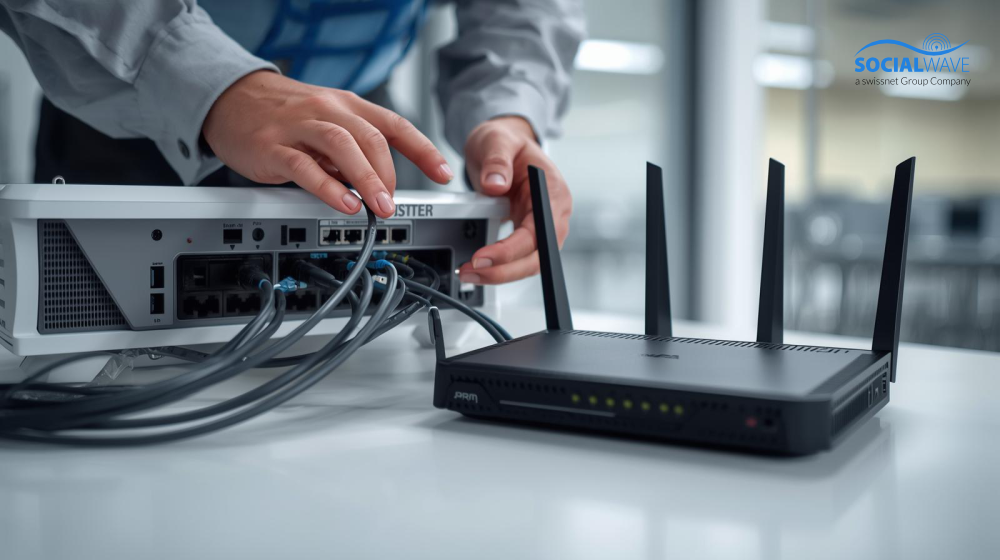LAN, WAN and WLAN: the basics of the Internet

Regardless of whether it's WAN, LAN, WLAN or even Wi-Fi. We deal with it every day: the internet. Loud Statista In 2018, the number of daily Internet users in Germany was 54 million. However, how it works, what needs to be considered to make it work and what technical terms are behind the global data network are rarely questioned. With this blog article, we want to clear up the ambiguities about some terms and explain the basics of network technology and its functions.
The digital mailing of data packages
Average 196 minutes a day The average consumer in Germany spends time on the Internet, but hardly anyone even knows how this network works. Basically, daily surfing on the World Wide Web is no different than sending digital mail. Data packets are sent from devices (such as smartphones or laptops) via the routers, which serves as an interface, transports it to the Internet and vice versa. Each of these devices has its own IP address (numeric code in the graphic below) in order to surfing to make it possible on the Internet. Based on the graphic shown below, this is then done as follows: The smartphone sends a data packet to the router, which forwards it to the Provider (Telekom in this example). The provider then sends these data packets on to the worldwide data network, the Internet.

The most important terms
LAN, WLAN and WAN
Probably the most common terms associated with the Internet are LAN and WLAN. Under LAN Do you understand “local area network”, which in German means something like “Local area network”. For example, the devices (smartphones or laptops) within a household that are connected to a router via a cable are referred to as a LAN. The antagonist to the LAN is WLAN. WLAN means “Wireless Local Area Network” and is the generic term for all wireless local area networks. Loud Statista Around 92% of Germans use their own WiFi at home. Wireless LAN can often also be found under the artificial term Wi-Fi. WAN Or even “Wide Area Network” This is called a network of computers or other devices over a larger area.
IP address
An Internet protocol address (in short: IP address) refers to a network address which may only be assigned once for each device in a specific network. It is necessary to assign an IP address in order to be able to correctly address and deliver data packets. Simply put, an IP address is that identification feature (the digital fingerprint) of a terminal device (for example from a computer or laptop), which allows you to recognize which provider is being used. An IP address consists of two parts: the first is the network address and the second part is the host address.
DNS
DNS, or even Dynamic Name Server It is called the big telephone directory and the soul of the World Wide Web. Without this server, the Internet would not work, which is why there are around 1000 servers worldwide, which make an attack almost impossible. Since the end user usually does not know the IP address of the website they are looking for, the DNS serves as a translator. It transforms the end user's search queries (for example: social-wave.de) to an IP address, which of the domain (social-wave.de) is assigned. The meaning behind this is rather trivial: People can remember words better, while machines need numbers.

DHCP
DHCP stands for “Dynamic Host Configuration Protocol” and is the service that saves us from having to configure our smartphone. Each device individually in one IP network Integration would be possible, but time-consuming and error-prone. The DHCP server automates this process and equips devices with IP addresses and other configuration data.

Router — the gateway to the Internet
The routers is the interface between LAN and WAN. It therefore connects the home network to the Internet. The purpose of the router is to transport data packets from the LAN to the WAN and vice versa. Simply put, it serves routers to determine the next network point to which a packet must be forwarded.
The basics summarized
Here we have summarized the most important basics and terms of the Internet for you once again:
- There are local and public networks whose names LAN and WAN are.
- WLAN is a technology for wirelessly networking various devices.
- Every device on a network requires a IP address, which may only exist once in this network at a time.
- The routers is the gateway to the Internet and transports data from the local area network to the wide area network.
- DNS mediates between man and machine as a lexicon of the Internet.
- DHCP automatically supplies devices with the settings they need to operate on the Internet.








.svg)

.svg)
.svg)



